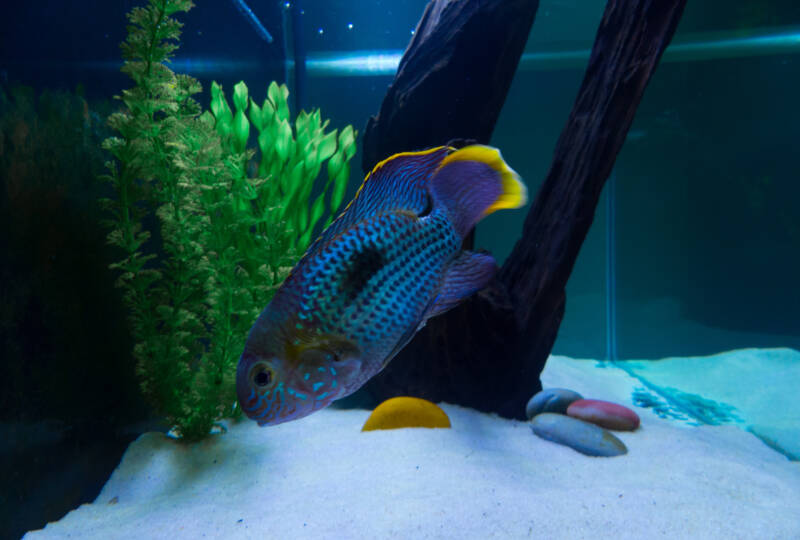If you’re a fan of cichlids, you’ve probably considered adding the green terror cichlid (Andinoacara rivulatus) to your tank.
Not only do they bring an astonishing variety of colors, but they have a vibrant personality to match, demonstrating curiosity in everyone that visits.
Of course, there’s that “terror” aspect you need to cope with. As beautiful as these fish are, they come with an aggressive streak that sets them apart from other fish.
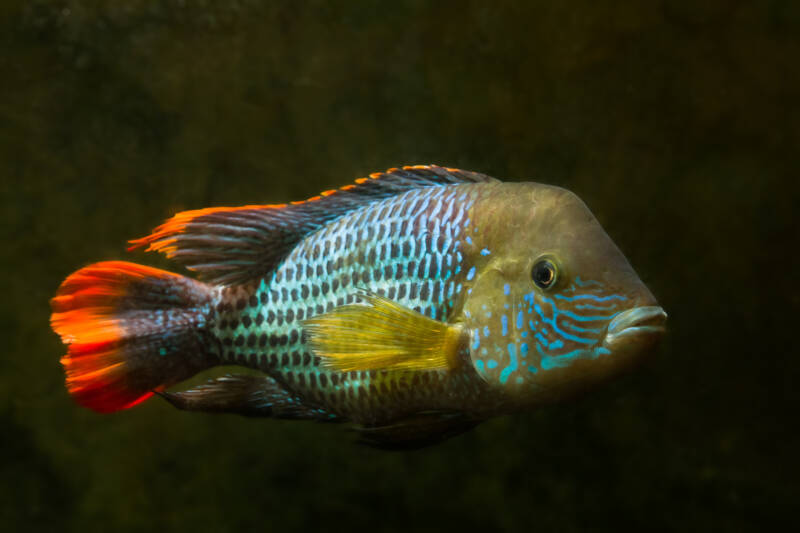
And if you’re not adept at managing angry, temperamental species? You probably need to find a different cichlid.
Green terrors require someone ready to work, not in terms of care (you need to prepare yourself in that department, too), but in temperament negotiation.
They’re NOT a fish for the amateur. But if you have some experience and want a challenge? You couldn’t do better.
At a Glance
| Minimum tank size: | 50 gal (227 l) for ONE; 75 gal (340 l) for a pair |
| School size: | pair recommended |
| Temperature: | 72-77°F (22-25°C) |
| Lifespan: | 7-10 years |
| Size: | 8 inches (20 cm) |
| pH: | 6.5-8.0 |
| Hardness: | 5-20 dH |
| Ammonia: | 0 ppm |
| Nitrite: | 0 ppm |
| Nitrate: | <40 ppm |
[toc]
In the Wild

Green terror cichlids frequent slow-moving rivers and backwaters throughout tropical Peru and Ecuador.
They stay inland, away from the brackish waters at the river mouths. And they’re not fans of the higher flowing portions of the river basins.
The brilliant metallic green of their scales earned them global popularity. And you’ll often see the silvery-blue juveniles for sale in fish stores.
As they age, the green becomes more prominent. Males also develop a rounded “hump” on their foreheads, especially during spawning season.
There are two different color morphs of green terrors, isolated to separate geographical regions.
Their differences are subtle, though, and it’s easy to confuse one for another. (Scientists mistook them for separate species in the beginning)
Gold Saum (Andinoacara rivulatus)
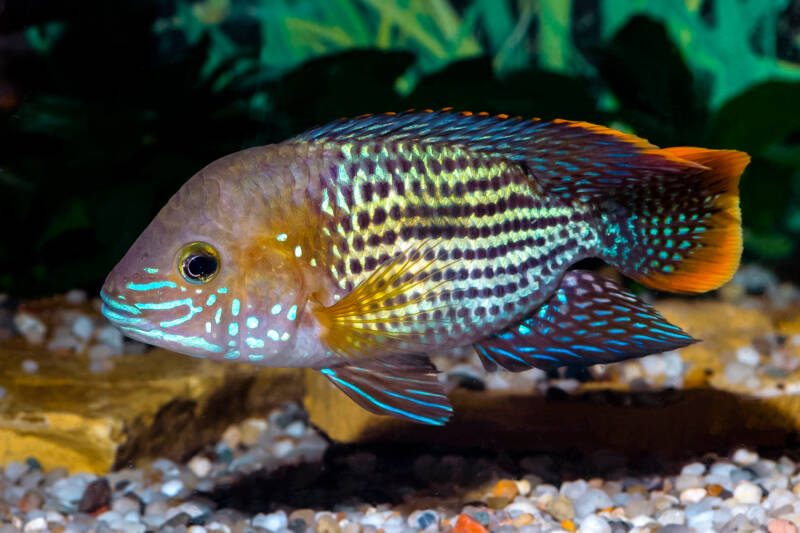
In the northwestern portions of Peru and western Ecuador, you’ll notice a bright orange or yellow margin to the caudal and dorsal fins.
These are “gold saums.” They’re the most popular color variety of the species.
White/Silver Saum (Andinoacara stalsbergi)
In western Peru, you’ll see a fish with white edges to its fins.
These are “white saums” and represent a separate species: Andinoacara stalsbergi. You’ll still see them called green terror cichlids, though. And they didn’t get separated until 2009.
As if that weren’t confusing enough, the blue acara (Aequidens pulcher) shares a similar blue and green color palette.
However, it’s a touch smaller with less green and doesn’t develop as much of a pronounced forehead hump. And in terms of aggression? They’re puppy dogs.
Size: Growing Pains

In the wild, green terror cichlids reach 12 inches (30 cm) long. But you don’t need to worry about that in a home aquarium.
The average these brutes achieve in captivity is around 8 inches (20 cm) – and that’s for the males (females aren’t as impressive).
Now, if you’re willing to offer your green terrors a little extra room, you MIGHT get your fish to grow out to 10 inches (25 cm) as adults.
A few aquarists recorded such lengths. But they used MASSIVE tanks and ponds to encourage their fish to grow.
Lifespan
If you’re considering taking on green terror cichlids – and their attendant aggression issues – you need to prepare for a long haul.
Their lifespan stretches for 7-10 years. That’s a big commitment for fish that will challenge your skills in behavioral management!
Behavior
What are green terror cichlids known for? Well, you don’t see “terror” in their name for nothing.
They’re incredibly aggressive. And since they’re benthopelagic, there isn’t any part of the tank they WON’T swim to and explore.
Territory is the name of the game with green terrors. As soon as they claim a region within a tank (usually the ENTIRE tank), they’ll defend it from any fish that dare to encroach.
This can mean turning smaller tank mates into snacks and leaving severe bite wounds on bigger neighbors.
And the smaller the space they’re crowded into? The worse that mean streak gets.
It goes DOUBLE for females. Contrary to most fish species, the ladies become bigger bullies, and they only worsen with age.
How can you help tamp down this habit?
By keeping a pair of green terrors. The male and female form a bond and share the territory within the tank. So it’ll lessen the mean streak in BOTH of them (at least until spawning season).
Tank Setup
With green terror cichlids, space is the most significant influence on aggression. And they aren’t small fish.
You don’t want to crowd them and end up with temperament problems. This means not going any smaller than 50 gallons (189 l) – for ONE green terror.
However, since it’s safer – and encouraged – to keep a bonded pair, you’ll want to increase your tank size to 75 gallons (284 l).
And if you decide to brave more than a pair, add 35 gallons (133 l) for each additional fish. That way you offer PLENTY of room.
Next, you need to scout an efficient filter. Green terror cichlids produce A LOT of waste.
They’re carnivorous omnivores – and large ones, at that. AND they’re sensitive to water conditions. So you’ll need to make sure you keep up with cleaning.
Your best bet is to look for a canister filter. Combined with 15-20% water changes every two weeks, you’ll end up with the best success.
Just ensure you can adjust the outflow. Green terrors don’t come from regions with a strong current, and they won’t appreciate a high water flow.
Water Conditions
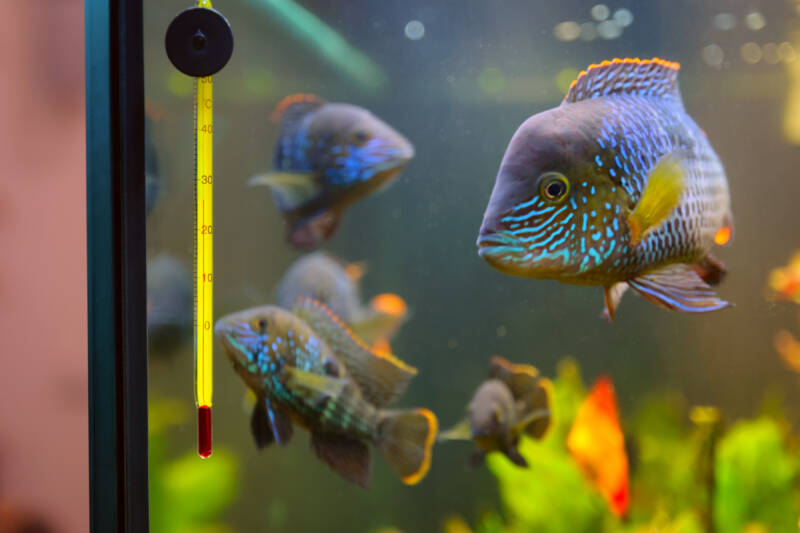
Green terror cichlids inhabit tropical regions of Peru and Ecuador. That means water temperatures of around 72-77F (22-25C).
Some aquarists use outdoor ponds to provide adequate green terror space. As long as the temp doesn’t go below 64F (18C), you’re gold.
They’re hardy fish, but sudden changes in water conditions? That can lead to stress.
And a stressed green terror will end up ill. As such, you want to keep your pH neutral (6.5-8.0) and your water relatively soft (5-20 dH).
More importantly, you need to keep an eye on the quality of the water.
That’s why you need an efficient filter that can stay ahead of the wastes they’ll produce. A handy test kit will help you monitor things.
Decorating the Green Terror Tank

As with any cichlid species, green terrors enjoy digging around in the substrate and redecorating the tank.
Keeping this behavior in the back of your mind will help you choose appropriate décor to ensure your fishes’ safety (and prevent YOUR aggravation).
Sand makes the best substrate. Your green terror cichlids can dig without injuring themselves (and it won’t lead to much displacement).
If you choose fine gravel, watch for potential impaction. It’s easy for a fish to accidentally ingest one of the rocks.
While green terrors prefer the meatier side of the menu, they will eat and uproot plants.
As they don’t need intense lighting, you’re better off choosing floating plants. Then you won’t need to worry about replanting the greenery:
- Amazon frogbit
- Anubias
- Duckweed
- Floating bladderwort
- Hornwort
- Java fern
- Water spangles
- Water sprite.
Natural barriers such as large rocks and driftwood will also help with territorial problems.
By breaking up the line of sight, your green terrors won’t charge after other fish that swim past the “boundaries.” And if you have more than a pair? This is a mandatory feature.
Green Terror Cichlids in Communities
Green terror cichlids earn their name (and reputations). But that doesn’t mean you’re stuck with a single-species tank.
If you put in the work with your décor and provide enough space for your fish to roam and explore, you CAN keep these colorful fish in a community tank.
However, if you have a bonded pair, you ALWAYS need to keep a second aquarium on hand. Spawning season spells trouble for any fish in the tank. You’ll need to separate the pair while they’re breeding to keep everyone protected.
Tank Mates
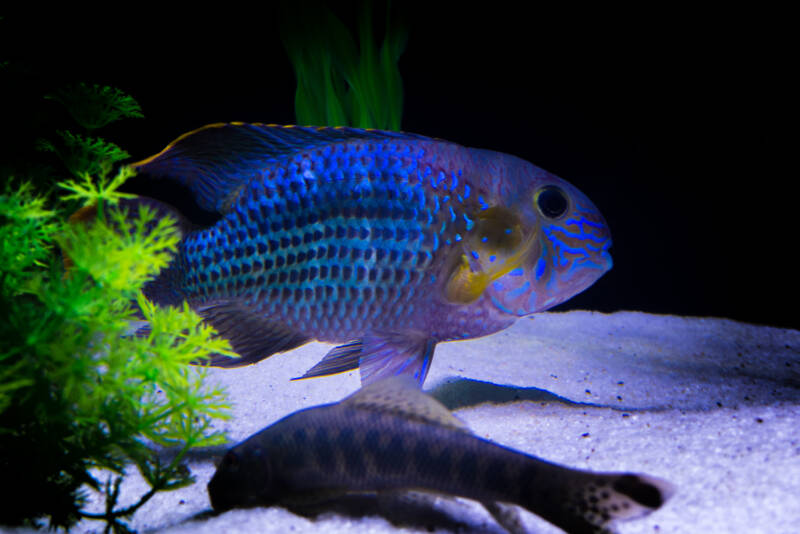
Green terror cichlids do well with fish their size or larger. That means you’ll need to provide space for everyone, but you’ll end up with an impressive community tank.
The following species get along fine – even with ferocious green terrors:
- Arowana
- Blood parrot cichlids
- Bristlenose plecostomus
- Clown plecostomus
- Convict cichlids
- Firemouth cichlids
- Flowerhorn cichlids
- Gars
- Jack Dempseys
- Jaguar cichlids
- Oscars
- Pacus
- Severums
- Silver dollars
- Striped Raphael catfish
- Synodontis catfish
- Texas cichlids
Of course, you’ll see additional fierce temperaments on this list.
Combining aggressive fish means taking the time to monitor everyone – and having a Plan B (just in case). You may need to separate your fish.
On the other hand, your green terrors may get along with their tank mates without a problem.
While it’s NOT recommended, some aquarists ended up with a green terror and Jack Dempsey breeding (ONLY in the absence of suitable partners, though).
Incompatible Species
Due to their predatory nature, you want to avoid adding smaller fish to your tank. However, even if they don’t provoke your green terror’s aggressive nature, they may end up as a snack.
Tank mates need to match or exceed green terror cichlids in size to remain safe.
The same goes for invertebrates. Crabs, shrimp, and snails are popular menu items for green terror cichlids. And since the fish explore EVERYWHERE within a tank, it won’t take them long to consume your crustaceans or mollusks.
Feeding Green Terror Cichlids
Wild green terror cichlids dine almost exclusively from the carnivore side of the menu.
But once you get them in a home aquarium, they’re a little more flexible and broaden into that omnivore palate. It makes feeding them a breeze.
You have free range to offer them anything from commercial fish foods to live or frozen protein sources and even the occasional vegetable. (Remember, they’ll sample the foliage you keep in the tank)
The important part is keeping a varied, balanced diet to prevent digestive problems.
If you’re looking for protein sources, DON’T choose beef hearts. Red meat contains too much protein for a green terror cichlid, and they’ll end up with digestive issues like bloat.
Instead, you want to pick frozen, freeze-dried, or live options more suited to the fish’s natural diet:
- Bloodworms
- Brine shrimp
- Crickets
- Earthworms
- Feeder fish
- Mussels
- Tubifex worms.
Given the option, green terrors will happily overeat. Then they end up bloated.
You only want to offer them as much as they can consume within a few minutes – no matter how much they beg.
Juveniles can receive three feedings a day while they’re growing. Adults? Twice a day‘s enough.
Breeding Green Terror Cichlids: Separation is Key
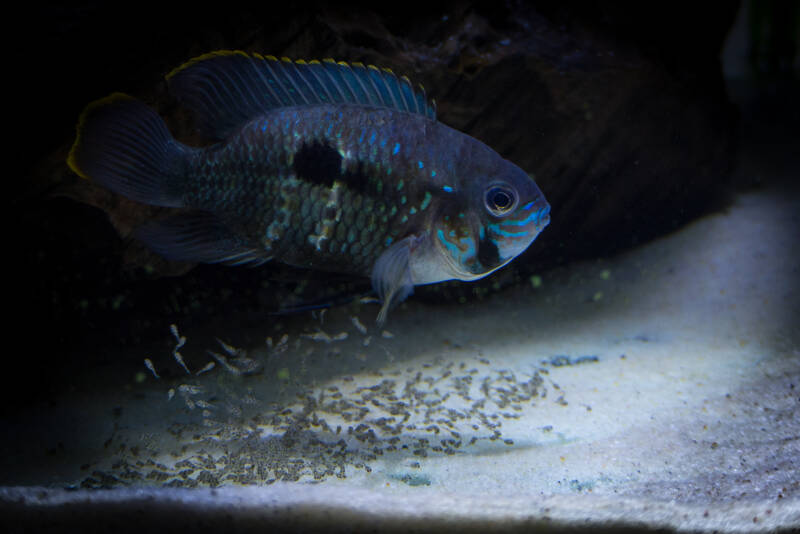
Breeding green terror cichlids isn’t difficult. If you have a happy, healthy bonded pair, they’ll probably produce eggs without a problem.
You may find yourself wishing they’d STOP. Especially because they’ll crank their aggression up during this time.
As such, you’ll want to have a separate tank available. This will keep your other fish safe. Both parents defend and care for their nest and young, and they WON’T hesitate to attack tank mates.
Have that breeding tank ready to go unless you want to deal with injuries (or death).
Male or Female?
Green terror cichlids have natural variations in their colors (remember the gold and white saums?).
So trying to look for a different shade between your fish won’t necessarily help you sort male from female when you start looking.
Occasionally, female green terrors won’t demonstrate the stripes you see on the dorsal and caudal fins. Of course, that could mean you have a different variety. You’re better off looking for duller colors and a smaller size.
If you catch the fish during the spawning season, males develop a nuchal hump. The fatty tissue grows when the fish prepare to breed in the wild.
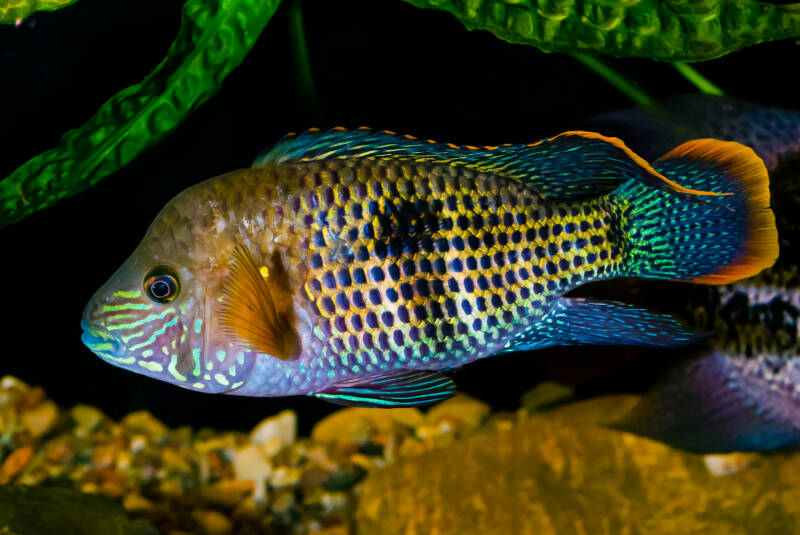
And in aquariums, they tend to remain permanent. It’s the easiest way to tell the sexes apart – in mature fish, anyway.
Excessive Aggression
Green terror cichlids often form bonded pairs on their own.
If you set up two fish in a proper tank with healthy water conditions and provide a suitable diet? The odds are high they’ll pair off and decide to start breeding.
That’s your cue to have that breeding tank ready. You can then transfer the pair over and adjust conditions to trigger a spawning event. Gradually increase the water temperature to 77-88F (25-31C) and offer feedings with live food.
You’ll know the pair’s ready when you see them cleaning a spot on the substrate.
Usually, they pick a flat rock, but some green terrors will scrape away all of the sand and use the glass bottom of the aquarium.
During the evening hours (or the early morning), the female will lay 200-1000 eggs in a figure 8 pattern.
Then the male follows behind and fertilizes them. This is when they go to work with those parenting skills.
The female waves her fins over the yellow eggs, creating a gentle current. And the male guards the nest and female against possible predators.
If left in the community tank? He’ll consider ANYTHING a threat and attack. Even YOUR hand can suffer bites if you reach into the tank.
Within 3-4 days, the eggs hatch. They survive on their yolk sac for another 2-4 days. Then they’re ready for infusoria and brine shrimp nauplii.
The parents continue to watch over and protect the fry, though, so be careful how you introduce the foods.
Once the green terror parents feel the fry are large enough and strong enough to fend for themselves, they’ll back off.
That’s when their hormones decrease, and the “hyper-aggression” ebbs. You can then transfer everyone back to the community tank.
Green Terror Cichlid Health
In general, green terror cichlids come out on the hardy end of the scale. As long as you provide sufficient water quality and an aquarium with room to explore (and patrol), they’ll remain healthy.
It’s when they become stressed or water quality drops that you see problems.
Poor water conditions are the biggest culprit for health problems in green terrors. You can see any of the following develop:
- Head and Lateral Line Erosion: Holes develop on the head or body. (You’ll also see it referred to as “Hole-in-Head Disease”)
- Ich: Stress levels allow the parasite to gain easy access to green terrors.
- Lymphocystis: The white lesions often get confused for Ich. But this viral infection goes into the connective tissue. Green terrors can end up suffocating without treatment.
Green Terror Cichlids: Are They For You?
Green terror cichlids carry that fearsome reputation, but it hasn’t damaged their popularity.
You won’t have any trouble finding one, usually for around $7 – for a juvenile. If you’re hoping to bring home a mature fish, the price depends on the size.
They’re not the most expensive freshwater fish out there, especially considering their scales’ dramatic play of color. But if you’re not prepared to handle that aggression, you might want to hold off.
Green terrors DO show curiosity towards visitors. They also learn to recognize their owners, similar to oscars.
It’s a playful side to an otherwise nasty bully. And it’s crucial that you understand BOTH sides of that personality before adding one to your collection.
Beautiful and Lethal
Green terror cichlids add a perfect punch of color to any tank. But their personalities? Well, there’s a different kind of punch there.
If you aren’t prepared, you could end up seeing “terror” spread through your tank. Make sure you know what you’re getting into!
Do you have green terror cichlids? Is it a single fish or a bonded pair?
How do you handle their breeding?
Share your stories and questions with us here!

